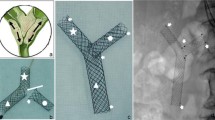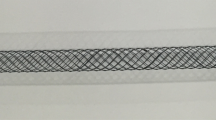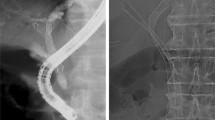Abstract
Purpose
To evaluate the technical feasibility and clinical efficacy of placement of a newly designed Y-shaped branched covered stent for palliative treatment of malignant hilar biliary obstruction.
Methods
From June 2011 to September 2014, 34 consecutive patients with malignant hilar biliary obstruction underwent percutaneous placement of a Y-shaped branched covered stent for palliative treatment. Technical and clinical success, complications, cumulative patient survival, and stent patency were evaluated.
Results
Stent placement was technically successful in all patients. All patients showed adequate biliary drainage on the follow-up cholangiogram. Mean serum bilirubin level (10.9 mg/dl) decreased significantly 1 week (5.7 mg/dl) and 1 month (2.6 mg/dl) after stent placement (p < 0.01). Complications associated with the procedure included hemobilia (n = 3) and biloma (n = 1). During the mean follow-up period of 225 (range 12–820) days, nine patients (26.5 %) developed stent occlusion caused by tumor overgrowth (n = 8) and sludge (n = 1). Two of them underwent coaxial placement of a second stent with good results. The median survival time was 281 days and median primary stent patency was 337 days. There were no significant differences in the patient survival and stent patency rates in relation to age, sex, or Bismuth type.
Conclusion
Percutaneous placement of the Y-shaped branched covered stent seems to be technically feasible and clinically effective for palliative treatment of malignant hilar biliary obstruction.





Similar content being viewed by others
References
Mihalache F, Tantau M, Diaconu B, Acalovshi M. Survival and quality of life of cholangiocarcinoma patients: a prospective study over a 4 year period. J Gastrointestin Liver Dis. 2010;19:285–90.
Bismuth H, Castaing D, Traynor O. Resection or palliation: priority of surgery in the treatment of hilar cancer. World J Surg. 1988;12:39–47.
LaBerge JM, Doherty M, Gordon RL, Ring EJ. Hilar malignancy: treatment with an expandable metallic transhepatic biliary stent. Radiology. 1990;177:793–7.
Kim CW, Park AW, Won JW, Kim S, Lee JW, Lee SH. T-configured dual stent placement in malignant biliary hilar duct obstructions with a newly designed stent. J Vasc Interv Radiol. 2004;15:713–7.
Ahn SJ, Bae JI, Han TS, et al. Percutaneous biliary drainage using open cell stents for malignant biliary hilar obstruction. Korean J Radiol. 2012;13:795–802.
Gwon DI, Ko GY, Kim JH, et al. Percutaneous bilateral metallic stent placement using a stent-in-stent deployment technique in patients with malignant hilar biliary obstruction. Am J Roentgenol. 2013;200:909–14.
Hwang JC, Kim JH, Lim SG, Kim SS, Yoo BM, Cho SW. Y-shaped endoscopic bilateral metal stent placement for malignant hilar biliary obstruction: prospective long-term study. Scand J Gastroenterol. 2011;46:326–32.
Kim DU, Kang DH, Kim GH, et al. Bilateral biliary drainage for malignant hilar obstruction using the ‘stent-in-stent’ method with a Y-stent: efficacy and complications. Eur J Gastroenterol Hepatol. 2013;25:99–106.
Bae JI, Park AW, Choi SJ, et al. Crisscross-configured dual stent placement for trisectoral drainage in patients with advanced biliary hilar malignancies. J Vasc Interv Radiol. 2008;19:1614–9.
Gwon DI, Ko GI, Yoon HK, et al. Prospective evaluation of a newly designed T-configured stent graft system for palliative treatment of advanced hilar malignant biliary obstructions. J Vasc Interv Radiol. 2010;21:1410–8.
Gwon DI, Ko GI, Yoon HK, et al. Safety and efficacy of percutaneous Y-configured covered stent placement for malignant hilar biliary obstruction: a prospective, pilot study. J Vasc Interv Radiol. 2012;23:528–34.
Naitoh I, Ohara H, Nakazawa T, et al. Unilateral versus bilateral endoscopic metal stenting for malignant hilar biliary obstruction. J Gastroenterol Hepatol. 2009;24:552–7.
Kang BC, Lee SY, Chung HH. A newly designed Y-shaped covered stent in the palliative treatment of hepatic hilar malignant obstruction: case report. Korean J Radiol. 2013;14:97–101.
Sacks D, McClenny TE, Cardella JF, Lewis CA. Society of interventional radiology clinical practice guidelines. J Vasc Interv Radiol. 2003;14:S199–202.
Isayama H, Komatsu Y, Tsujino T, et al. A prospective randomised study of “covered” versus “uncovered” diamond stents for the management of distal malignant biliary obstruction. Gut. 2004;53:729–34.
Naitoh I, Hayashi K, Nakazawa T, et al. Side-by-side versus stent-in-stent deployment in bilateral endoscopic metal stenting for malignant hilar biliary obstruction. Dig Dis Sci. 2012;57:3279–85.
Gazelle GS, Lee MJ, Mueller PR. Cholangiographic segmental anatomy of the liver. Radiographics. 1994;14:1005–13.
Yasumori K, Mahmoudi N, Wright KC, Wallace S, Gianturco C. Placement of covered self-expanding metallic stens in the common bile duct: a feasibility study. J Vas Interv Radiol. 1993;4:773–8.
Kanasaki S, Furukawa A, Kane T, Murata K. Polyurethane-covered Nitinol Strecker stents as primary palliative treatment of malignant biliary obstruction. Cardiovasc Intervent Radiol. 2000;23:114–20.
Thurnher SA, Lammer J, Thurnher MM, Winkelbauer F, Graf O, Wildling R. Covered self-expanding transhepatic biliary stents: clinical pilot study. Cardiovasc Interv Radiol. 1996;19:10–4.
Han YM, Hwang SB, Lee ST, Lee JM, Chung GH. Polyurethane-covered self-expandable nitinol stent for malignant biliary obstruction: preliminary results. Cardiovasc Interv Radiol. 2002;25:381–7.
Han YM, Kwak HS, Jin GY, Lee SO, Chung GH. Treatment of malignant biliary obstruction with a PTFE-covered self-expandable nitinol stent. Korean J Radiol. 2007;8:410–7.
Tsang TK, Pollack J, Chodash HB. Silicone-covered metal stents an in vitro evaluation for biofilm formation and patency. Dig Dis Sci. 1999;44:1780–5.
Bang BW, Jeong S, Lee DH, Lee JI, Lee SC, Kang SG. The biodurability of covering materials for metallic stents in a bile flow phantom. Dig Dis Sci. 2012;57:1056–63.
Krokidis ME, Hatzidakis AA, Manousaki EG, Gourtsoyiannis NC. Late migration of two covered biliary stents through a spontaneous bilioenteric fistula in a patient with malignant biliary obstruction. Cardiovasc Interv Radiol. 2008;31:222–5.
Kim JW, Gwon DI, Han YM, et al. A prospective, multicenter study of a double stent system for palliative treatment of malignant extrahepatic biliary obstructions. Acta Radiol. 2015;56:1209–15.
Petersen BD, Timmermans HA, Uchida BT, Rabkin JM, Keller FS. Treatment of refractory benign biliary stenoses in liver transplant patients by placement and retrieval of a temporary stent-graft: work in progress. J Vasc Interv Radiol. 2000;11:919–29.
Jang JK, Song HY, Kim JH, Song M, Park JH, Kim EY. Tumor overgrowth after expandable metallic stent placement: experience in 583 patients with malignant gastroduodenal obstruction. Am J Roentgenol. 2011;196:W831–6.
Acknowledgments
We would like to acknowledge So Hee Jung, PhD, for her assistance in preparing the manuscript.
Author information
Authors and Affiliations
Corresponding author
Ethics declarations
Conflict of interest
Jong Hyouk Yun, Gyoo-Sik Jung, Jung Gu Park, Byung Chul Kang, Dong-Hoon Shin, Byung Chul Yun, and Sang Uk Lee declare that they have no conflict of interest.
Rights and permissions
About this article
Cite this article
Yun, J.H., Jung, GS., Park, J.G. et al. Malignant Hilar Biliary Obstruction: Treatment by Means of Placement of a Newly Designed Y-Shaped Branched Covered Stent. Cardiovasc Intervent Radiol 39, 582–590 (2016). https://doi.org/10.1007/s00270-015-1205-1
Received:
Accepted:
Published:
Issue Date:
DOI: https://doi.org/10.1007/s00270-015-1205-1




